Subchapter T Rules
-
- USCG Maritime Reporter, Mar 2013 #32
ADM Bob Papp’s Coast Guard tenure continues to be one of low profile victories, calm leadership and an emphasis on doing what is right for the Coast Guard.
U.S. Coast Guard Commandant Adm. Bob Papp delivered the 2013 State of the Coast Guard (SOCG) Address at the National Defense University at Fort Lesley J. McNair in Washington, D.C. on February 27. When
Adm. Papp assumed command of the Coast Guard in May of 2010, he had the unenviable task of following perhaps the most charismatic leader the Coast Guard has ever had. The high profile Thad Allen, dubbed by the mainstream media as “the rock star” Commandant, also more earned his reputation by firm leadership over the course of more than one highly visible crisis after another.
Papp, like Tom Collins who had to follow another popular commandant (Jim Loy), has had to carve out his own niche in different ways. And, whereas Collins had his own cross to bear as he navigated the inauspicious beginning of the Deepwater recapitalization plan with a Coast Guard that was at that time ill-prepared to undertake that task, Papp has been faced with tackling some of the ambitious projects started by his predecessors, but never finished. That work continues today. Those looking to Papp for fireworks and flash as he goes about his daily business will be sorely disappointed. On the other hand, if it is quiet, firm and consistent leadership that today’s Coast Guard is thirsting for, then Papp has been the RX that is slowly, but surely righting a dangerously overloaded ship, while stowing all of the important gear in the right places.
Papp’s latest SOCG speech was filled with nautical metaphors, but also much in the way of substance. And, reflecting the use of another federal property to deliver that message in these austere times, he also addressed the key challenges ahead for the nation’s fifth, uniformed, armed service.
As the Coast Guard finally nears its departure from the tired old headquarters at the end of 2nd Street and prepares to move into its state-of-the-art, brand new digs, there are still many challenges ahead. As he promised more than two years ago, Papp has concentrated on finishing what others have started, and during his speech, he pointed to the field level reorganization efforts started by ADM Tom Collins many years ago. Papp said, “This year we completed the field level reorganization to Sectors. The wisdom of those efforts was demonstrated during this storm (Sandy) by watching all elements of Response and Prevention and Logistics work together during our operations.” Other unfinished tasks include the continued recapitalization of the Coast guard’s aging assets, the upper leadership reorganization started by Allen but never authorized by Congress and the critical need to address the growing requirement for Coast Guard presence in the Arctic.
Also, Papp outlined just a few of the many heroic and successful rescue operations undertaken by the Coast Guard during the busy previous 12 months. That said, he then cautioned his audience that good prevention is preferable to even the best response. Unspoken in all of that might just be the ongoing regulatory changes just around the corner for the industry that Papp regulates. These include the finalization of ballast water technology approvals and enforcement, the coming subchapter “M” rules for previously uninspected inland vessels and the Maritime Labor Convention (2006), which provides comprehensive rights and protection at work for the world’s more than 1.2 million seafarers. Arguably, all of these are aimed at prevention, as opposed to response. Right up Papp’s alley, so it would seem.
Sequestration predictably came up during Papp’s remarks. And although the Commandant expressed optimism that the Coast Guard would be able to continue meeting its missions because of the service’s greatest asset, its people, he also provided a small window into what could come as the shadow of sequestration looms over the entire federal budget. He said, in part, “… I am concerned that shrinking budgets have impacted our ability to hold courses, pay for travel to training and provide the necessary extra boat and aircraft hours. We must continually seek smarter, more innovative and more economical ways to provide these experiences. Our people deserve it and our service to the public demands it.” But, like his predecessor, ADM Thad Allen, who once said, “We’re done doing more with less,” Papp took it a step further by declaring, “… we may be asked to do less with less.”
Papp concluded his remarks, as any career cutterman should, with a few more nautical metaphors. He said, with veiled reference to his efforts to complete the unfinished work left by previous leadership, “Our job – our mission – is to set a course for the Service. We must put our efforts into moving forward, prudently navigating towards the horizon.” Arguably, he and his subordinates are already doing just that, within the constraints of a multi-missioned, inadequately funded mandate that seems to grow with each passing day.
Three for the Money
(Your money, that is)
The U.S. Coast Guard is currently bandying about three different regulatory issues, in various drafts and forms. These include the certification of ballast water treatment technologies, the final wording of the so-called “subchapter M” rules for inland vessels and now a draft NVIC circular regarding the MLC 2006 Code (which is covered in detail by Dennis Bryant this month, please see page 14). Chances are at least two out of three will cost you (a lot of) money.
Ballast Water Treatment Technology
Ballast Water Treatment and Technology in a nutshell: the IMO has enough countries but not the required percentage of the world’s fleet for ultimate ratification of their rule. The USCG rules are final and in place, the discharge standards are essentially identical to IMO. The process for USCG certification of BWMS is in place but no one has yet gone through it.
When the Coast Guard’s final rule on ballast water management became effective this past June, this momentous event perhaps signaled the end of one arduous journey for regulators, but the beginning of another for shipowners. The U.S. rule establishes discharge standards for living organisms which ballast water management systems (BWMS) must be able to satisfy. This so-called phase one standard closely conforms to the IMO’s version, bringing the dream of global standardization one step closer. Despite delays by various governments, the IMO standard is widely expected to enter into force within the next two years.
It is also not hard to understand why so few operators have, to date, installed BWMS on their vessels. The depressed state of global shipping markets over the past few years certainly has played a role. Not everyone has the reported average price of $1 million per ship needed to install the systems, and those who do, are reluctant to do so until they absolutely have to. Also lurking just around the corner is the separate, but equally important U.S. Environmental Protection Agency’s ongoing Vessel General Permit process, which also covers ballast water discharges. Adding to that uncertainty is the myriad of individual U.S. state mandates still in play and the specter of a stricter U.S. Coast Guard (phase II) standard. The U.S. Coast Guard’s certification of BWMS can take the form of an Alternate Management System (AMS), which gives a five year temporary window for flag approved systems, or permanent type approval. USCG Type approval will require (a.) that biological laboratory testing has been done AND (b.) shipboard tests as well. Applications for approvals will take about 60 days to get a verdict. If you’ve passed the testing, then type approval is possible. If not, technologies will need to go the AMS route. And it is important to note that once a ballast water management system has been approved by the Coast Guard and made available for certain classes, types or a specific vessel, then vessels will no longer be able to install AMS in lieu of type approved system(s). The five-year period is designed to provide the BWMS manufacturer time to obtain USCG approval. Any vessel using an AMS must still comply with the terms and conditions of the U.S. EPA Vessel General Permit (VGP). The proposed 2013 VGP already contains discharge limits similar to the IMO D-2 standard.
The 600-pound gorilla in the room, however, is the reality that if you wait too long to decide on a system and have it installed, you could be paying double the price because manufacturing capacities can’t possibly keep up with the demand of as many as 50,000 vessels all needing the systems at once. You might not be able to get the system at all.
Subchapter M Rules
Pending USCG Subchapter “M” (SubM) regulations will eventually require towing operators to implement safety standards and use safety management systems, or alternatively, allow for an annual Coast Guard inspection regime. The new rules are expected to allow towing vessel organizations to customize their approach to meeting the requirements, while providing oversight using audits, inspections, and reviews of safety data. As many as 5,000 vessels and their operators will eventually feel the impact of the so-called subchapter M rules. Today, almost 1,800 domestic towing vessels do not participate in any formal industry safety schemes.
With the final language not yet determined, the ultimate cost of this far-reaching mandate is unknown. But the numbers are staggering, especially for barge companies currently operating without an existing Safety Management System (SMS) – could reach as much as $350,000. And that number doesn’t even include the cost of needed equipment upgrades. Let’s hope the Coast Guard is up to the task of facilitating competent, timely and most importantly, fair implementation of all of these new regulations. Any one of these three mandates constitutes a serious challenge for any regulatory body; all three at once will be daunting.
(As published in the March 2013 edition of Maritime Reporter & Engineering News - www.marinelink.com) -
- Service Marine Christens 600-Passenger Paddlewheeler For Heritage Cruise Lines Maritime Reporter, Jun 1988 #10
., called the Annabel Lee "a 90- day miracle," since that's how long the vessel took to construct. The boat is certified by the U.S. Coast Guard under Subchapter T rules for carrying over 150 passengers for service on lakes, bays and sounds, and partially protected waters. For free literature on the boatbuildi
-
- Interim USCG Acceptance Of Perko Navigation Lights For Ships Over 20 Meters Maritime Reporter, Jan 1978 #34
for the regulations in effect now occurred on March 31, 1977, when the Coast Guard published an amendment to the Federal Register that added a new subchapter DD (33CFR 87) to the navigation and navigable water regulations. This new subchapter defines rules for implementing and interpreting the International
-
- Aluminum Boats Delivers Sleek 140-Foot Dinner Yacht Maritime Reporter, Sep 1990 #8
Waterway, normally inaccessible to vessels her size. A skegs protects her props and rudders. Built to U.S. Coast Guard standards under subchapter T rules and regulations, the new boat is powered by two Caterpillar 3408TA diesel engines driving through Twin Disc reverse reduction gears. The
-
- Hornblower Dining Yachts Contracts Trinity Marine Group To Build West Coast's Largest Diner Boat Maritime Reporter, Jan 1989 #14
will drive through Twin Disc MG-518 reverse/reduction gears with a ratio of 4.06:1. The California Hornblower will be built under U.S. Coast Guard subchapter "T" rules and regulations and will meet American Bureau of Shipping (ABS) standards. The California Hornblower is now under construction at Trinity's
-
- OUTSTANDING PASSENGER VESSELS OF 1990 Maritime Reporter, Jan 1991 #30
Waterway, normally inaccessible to vessels her size. A skegs protects her props and rudders. Built to U.S. Coast Guard stand ards under subchapter T rules and regulations, the new boat is powered by two Caterpillar 3408TA diesel engines driving through Twin Disc reverse reduction gears. The
-
- The C-Hero Story: Marine News, Jan 2019 #47
its industrial products network in the rest of the world. For workboat operators in domestic waters, that’s especially important in light of the new subchapter M rules that now specifically require MOB drills to take place. For the nation’s 6,000+ subchapter T, H and K passenger vessels, it could mean the
-
- Committees, Associations, and Societies Maritime Reporter, Apr 2003 #61
crafted. The Coast Guard recognized the quality effort that went into the PVA response and listened carefully to PVA's opinions. As a result, the Subchapter T and Subchapter K rules that we are using today are workable and accepted by industry. Similarly, when barges pushed by the tug MAUVILLA collided
-
- Reducing Human Error & Near Miss Incidents Marine News, Oct 2014 #8
rule for inspection of towing vessels should emphasize SMS implementation to the fullest extent possible. Of course, here, they are talking about the Subchapter M towboat rules. Again, this sounds like a great idea. And, industry, for once, is dying to have the subchapter M rules ratified. We ask again: what
-
- BY THE NUMBERS Marine News, Jun 2019 #10
vessels, and the newest members of the inspected fleet, towing vessels. With the addition of towing vessels, which started getting inspected under 46 CFR Subchapter M in July of 2018, the size of the U.S. inspected fleet grew by approximately 6,500 vessels to a total fleet size of nearly 20,000 vessels, an increase
-
- Subchapter M Looms Operators and Suppliers Respond Marine News, May 2013 #10
that the Sunshine state has to offer. At the same time, they also got a full dose of reality when it comes to the eventual implications of the subchapter M rules. Maritime attorney and consultant Gary English led the attendees through a comprehensive primer on who will be impacted, why, and what it
-
- Safety Management Systems: A Good fit for Passenger Vessels? Marine News, Jan 2019 #30
a long time, and take their most prominent roots from blue water shipping. Eventually – in places like the towboat industry’s newly regulated Subchapter M rules – those procedures and systems found their way into brown water operations. They are here to stay. Some passenger vessel operators
-
 )
April 2024 - Maritime Reporter and Engineering News page: 43
)
April 2024 - Maritime Reporter and Engineering News page: 43“The industry is an ecosystem which includes owners, managers, mariners, shipyards, equipment makers, designers, research institutes and class societies: all of them are crucial,” – Eero Lehtovaara, Head of Regulatory & Public Affairs, ABB Marine & Ports All images courtesy ABB Marine and Ports provi
-
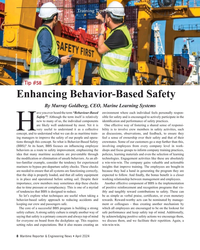 )
April 2024 - Maritime Reporter and Engineering News page: 8
)
April 2024 - Maritime Reporter and Engineering News page: 8Training Tips for Ships © By tuastockphoto/AdobeStock Tip #58 Enhancing Behavior-Based Safety By Murray Goldberg, CEO, Marine Learning Systems ave you ever heard the term “Behaviour-Based environment where each individual feels personally respon- Safety”? Although the term itself is relatively sible for
-
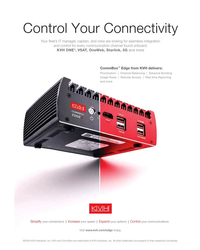 )
April 2024 - Maritime Reporter and Engineering News page: 5
)
April 2024 - Maritime Reporter and Engineering News page: 5Control Your Connectivity Your ?eet’s IT manager, captain, and crew are looking for seamless integration and control for every communication channel found onboard: ® KVH ONE , VSAT, OneWeb, Starlink, 5G and more ™ CommBox Edge from KVH delivers: Prioritization | Channel Balancing | Advance Bonding
-
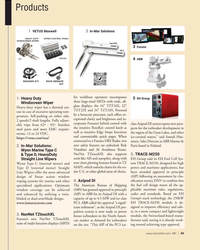 )
April 2024 - Marine News page: 43
)
April 2024 - Marine News page: 43Products 1 2 VETUS Maxwell In-Mar Solutions 3 Furuno ABB 4 for workboat operators encompasses EH Group 1. Heavy Duty 5 three large-sized MFDs with wide, all- Windscreen Wiper glass displays: the 16” TZT16X, 22” Heavy-duty wiper has a thermal cut- TZT22X and 24” TZT24X. Powered out in
-
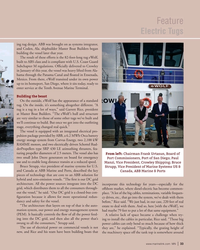 )
April 2024 - Marine News page: 33
)
April 2024 - Marine News page: 33the vessel later that year. The result of these efforts is the 82-foot-long tug eWolf, built to ABS class and is compliant with U.S. Coast Guard Subchapter M regulations. Of? cially delivered to Crowley in January of this year, the vessel was heavy lifted from Ala- bama through the Panama Canal and
-
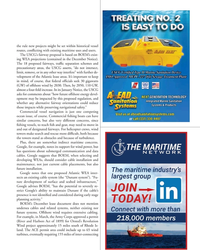 )
April 2024 - Marine News page: 23
)
April 2024 - Marine News page: 23the rule new projects might be set within historical vessel routes, con? icting with existing maritime uses and users. The USCG’s fairway proposal is based on BOEM’s exist- ing WEA projections (contained in the December Notice). The 18 proposed fairways, traf? c separation schemes and precautionary
-
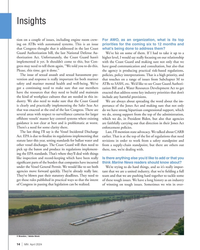 )
April 2024 - Marine News page: 14
)
April 2024 - Marine News page: 14, policy interpretations. That is a high priority, and vention and response is really important for both mariner that touches on a range of issues from Subchapter M to safety and mariner mental health and well-being. We’ve ATBs to SASH, etc. We’d like to see Coast Guard Authori- got a continuing need to make
-
 )
April 2024 - Marine News page: 13
)
April 2024 - Marine News page: 13AWO is Guard is applying crewing and life-saving requirements to currently paying attention to? ATBs from one unit to another. Those differences don’t Subchapter M, believe it or not, we are getting ready to, seem to be driven primarily by risk, by the speci? c op- for some vessels embark on the COI renewal
-
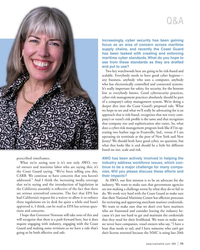 )
April 2024 - Marine News page: 11
)
April 2024 - Marine News page: 11Q&A Increasingly, cyber security has been gaining focus as an area of concern across maritime supply chains, and recently the Coast Guard has been tasked with creating and enforcing maritime cyber standards. What do you hope to see from these standards as they are drafted and put to use? Two key
-
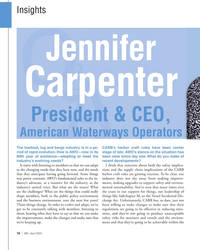 )
April 2024 - Marine News page: 10
)
April 2024 - Marine News page: 10the things that could really the years in our support for things, our leadership of shape members, both in the public policy environment things like Subchapter M, or the Vessel Incidental Dis- and the business environment, over the next few years? charge Act. Unfortunately, CARB has, to date, just not Those
-
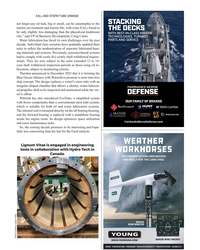 )
February 2024 - Maritime Reporter and Engineering News page: 33
)
February 2024 - Maritime Reporter and Engineering News page: 33EAL AND STERN TUBE DAMAGES STACKING not forget any oil leak, big or small, can be catastrophic to the marine environment and marine life, with some EALs found to THE DECKS be only slightly less damaging than the phased-out traditional WITH BEST-IN-CLASS MARINE oils,” said VP of Business Development
-
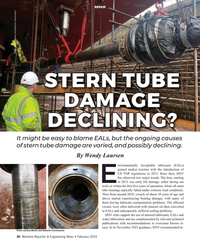 )
February 2024 - Maritime Reporter and Engineering News page: 30
)
February 2024 - Maritime Reporter and Engineering News page: 30REPAIR Photo courtesy Marine and Industrial Transmissions STERN TUBE DAMAGE DECLINING? It might be easy to blame EALs, but the ongoing causes of stern tube damage are varied, and possibly declining. By Wendy Laursen nvironmentally Acceptable lubricants (EALs) gained market traction with the introduction
-
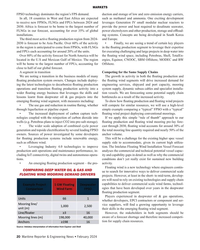 )
February 2024 - Maritime Reporter and Engineering News page: 20
)
February 2024 - Maritime Reporter and Engineering News page: 20MARKETS FPSO technology dominates the region’s FPS demand. duction and storage of low and zero emission energy carriers, In all, 18 countries in West and East Africa are expected such as methanol and ammonia. One exciting development to receive new FPSOs, FLNGs and FPUs between 2024 and leverages
-
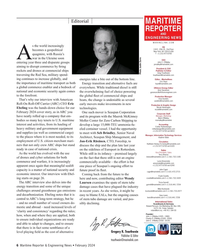 )
February 2024 - Maritime Reporter and Engineering News page: 6
)
February 2024 - Maritime Reporter and Engineering News page: 6Editorial MARITIME REPORTER AND ENGINEERING NEWS M A R I N E L I N K . C O M s the world increasingly HQ 118 E. 25th St., 2nd Floor becomes a geopolitical New York, NY 10010 USA T +1.212.477.6700 quagmire, with Russia’s Awar in the Ukraine soon CEO John C. O’Malley entering year three and disparate
-
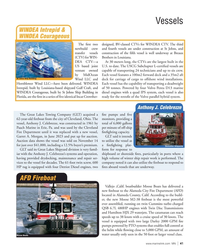 )
February 2024 - Marine News page: 41
)
February 2024 - Marine News page: 41Breaux (CTV) for WIN- Brothers in Louisiana. DEA CTV—a At 30 meters long, the CTVs are the largest built in the US based joint U.S. to date. The USCG Subchapter L-certi? ed vessels are venture owned capable of transporting 24 technicians and up to six crew. by MidOcean Each vessel features a 100m2 forward
-
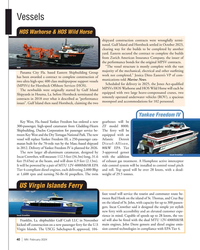 )
February 2024 - Marine News page: 40
)
February 2024 - Marine News page: 40for the U.S main engines, John Deere gensets and diesel engine emis- sion control technologies in compliance with EPA Tier 4. Virgin Islands. The USCG Subchapter-K approved, 104- 40 | MN February 202
-
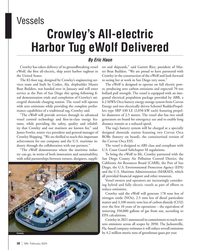 )
February 2024 - Marine News page: 38
)
February 2024 - Marine News page: 38with our partners.” The vessel is designed to ABS class and compliant with “The eWolf demonstrates where the maritime indus- U.S. Coast Guard Subchapter M regulations. try can go, in terms of both innovation and sustainability, To bring the eWolf to life, Crowley partnered with the with solid partnership
-
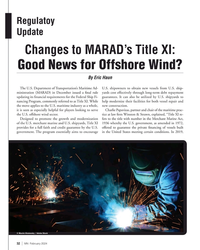 )
February 2024 - Marine News page: 32
)
February 2024 - Marine News page: 32Regulatoy Update Changes to MARAD’s Title XI: Good News for Offshore Wind? By Eric Haun The U.S. Department of Transportation’s Maritime Ad- U.S. shipowners to obtain new vessels from U.S. ship- ministration (MARAD) in December issued a ? nal rule yards cost effectively through long-term debt repayment
-
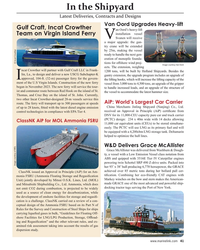 )
January 2024 - Maritime Reporter and Engineering News page: 41
)
January 2024 - Maritime Reporter and Engineering News page: 41will partner with Gulf Craft LLC in Frank- 1200 tons, will be built by Holland Shipyards. Besides the lin, La., to design and deliver a new USCG Subchapter-K gantry extension, the upgrade program includes an upgrade of Iapproved, 104-ft. (32-m) passenger ferry for the govern- the lifting hooks, which
-
 )
January 2024 - Maritime Reporter and Engineering News page: 7
)
January 2024 - Maritime Reporter and Engineering News page: 7Training Tips for Ships Tip #55 Maritime Micro-Learning for Mega-Bene? ts By Murray Goldberg, CEO, Marine Learning Systems n our industry as in most others, we typically see on- to be less expensive to update the speci? c microlearning mod- line training content presented as large, comprehensive ules in
-
![MR Dec-23#22 MEET THE CTO
ward] decarbonization, we had our eyes on the](https://images.marinelink.com/images/magazines/w200h250c/MaritimeReporter-202312-page24.png) )
December 2023 - Maritime Reporter and Engineering News page: 22
)
December 2023 - Maritime Reporter and Engineering News page: 22MEET THE CTO ward] decarbonization, we had our eyes on the year 2050 [pre- separately, every single combustion separately. mised on rules from the International Maritime Organization]. Already now, machine learning and arti? cial intelligence Now our programs – short-, medium- and long-term – are all
-
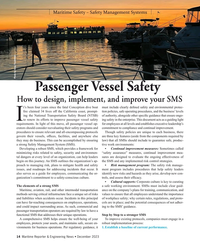 )
December 2023 - Maritime Reporter and Engineering News page: 14
)
December 2023 - Maritime Reporter and Engineering News page: 14Maritime Safety – Safety Management Systems Photo by Greg Trauthwein Passenger Vessel Safety How to design, implement, and improve your SMS t’s been four years since the fatal Conception dive boat must include clearly de? ned safety and environmental protec- ? re claimed 34 lives off the California coast
-
 )
December 2023 - Maritime Reporter and Engineering News page: 13
)
December 2023 - Maritime Reporter and Engineering News page: 13equally unenlightening. that the level of PFOS is at or below 1 ppm. Ragnar Kreft- Another point to consider is that manufacturers are already ing, Founder, Lifeclean explains that the process is perfectly switching to alternative products and there is always a pos- safe and produces less wastewater than
-
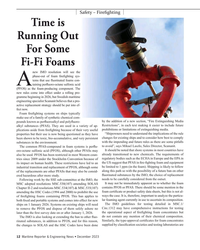 )
December 2023 - Maritime Reporter and Engineering News page: 12
)
December 2023 - Maritime Reporter and Engineering News page: 12Safety – Fire? ghting Time is Running Out For Some Fi-Fi Foams new IMO resolution will see the phase-out of foam ? re? ghting sys- tems that use ? uorinated foams con- A taining per? uoro-octane sulfonic acid (PFOS) as the foam-producing component. The new rules come into effect under a rolling
